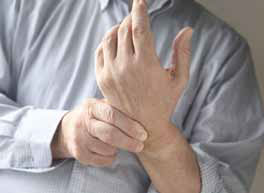
Do you have a bump on the wrist your physician called a ganglion cyst? These soft-tissue fluid-filled lumps are usually harmless, generally painless and often go away on their own. Ganglions can occur in any joint and may result from arthritis or from injury due to repetitive stress activities.
If the cyst is painful, interferes with function or has an unacceptable appearance, surgical removal is frequently the treatment of choice and the one most likely to prevent recurrence, because it removes the joint structures that act as a “root” for the cyst.
To treat ganglions located on the top of the wrist, the area numbed and the cyst is punctured with a needle so the fluid can be aspirated or drawn out; this does not remove the root of the cyst, so recurrence is likely. Because activity often causes ganglions to grow in size, thus increasing pressure on nerves, immobilizing the joint with a wrist brace or splint for a few weeks can relieve symptoms and allow the ganglion to shrink. Gentle and frequent massage can help move fluid out of the sac, encouraging the cyst to grow smaller.
When the cyst is removed or decreases in size, physical therapy can help reduce swelling and discomfort, and prevent future occurrences by teaching you exercises to increase hand strength, flexibility and coordination, and restore maximum range of motion (ROM)to the wrist and hand. Once learned, these exercises can be performed at home:
- passive ROM exercises (you, using the other hand, or your therapist moves your wrist)
- active ROM exercises (you move the wrist on your own)
- strengthening exercises with and without weights
- finger extensions using a special rubber band
- grip exercises using a ball
- resistance band exercises to improve ROM
We can devise an exercise program tailored to your specific needs to help prevent future joint injury and reduce the chances another cyst will form. Regaining full ROM and strength will enable your return to normal activities without pain or significant discomfort.
















